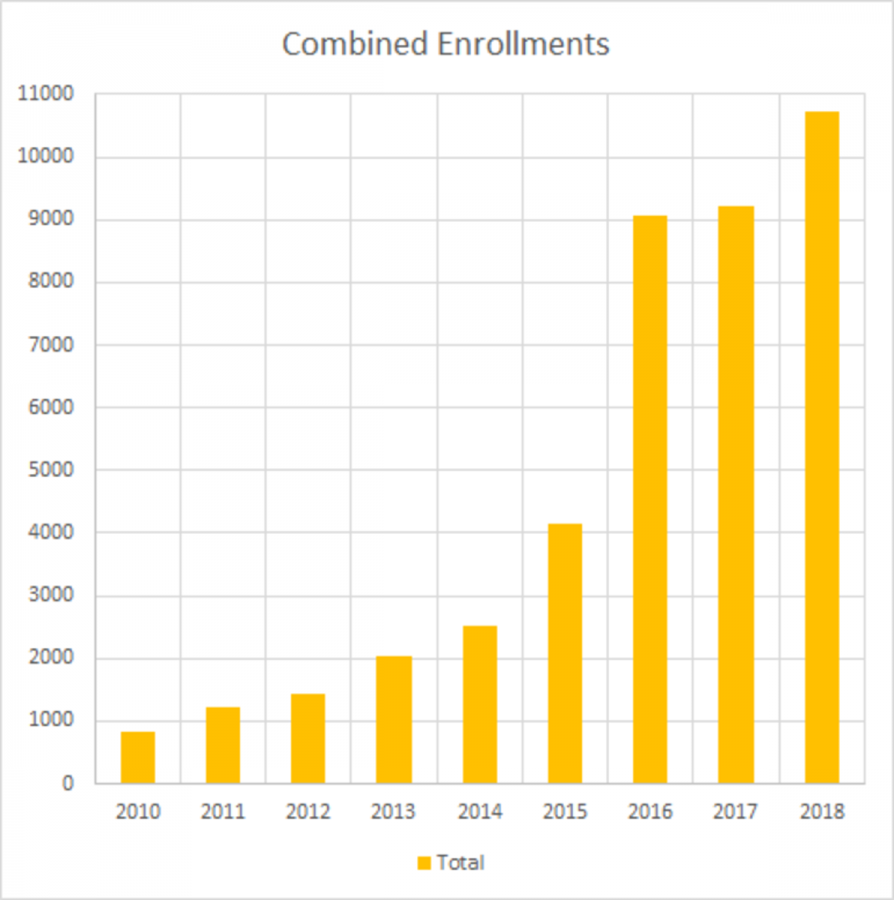Part 3: “An Educational Reboot”: How Technology is Changing the Quality of Learning
May 14, 2018
The number of online enrollments has skyrocketed from previous years.The number of online enrollments has skyrocketed from previous years, as evident by both graphs.
With options like online classes, personal devices and school-related apps on students’ phones, education is the most accessible it has ever been for students and teachers of the modern era.
Students can now access courses and classroom materials at any time, view topics in a variety of ways and take their work with them wherever they go.
And the advent of online classes has opened up an entirely new world of opportunities and challenges to students, and drastically changed the landscape of what classes look like.
However, the question remains of how much students benefit from this style of education versus a traditional classroom setting. How well can students retain and comprehend information when learning from a screen?
According to Fulton County’s Coordinator of Virtual Learning Tim Maley, the county’s aim in creating these courses is also based on flexibility and student-centered learning.
“A student can move at a rate that fits their academic needs,” he said. “The teacher is not worried about what they’re broadcasting to a classroom of students. They’re providing very tailored support to an individual.”
This model has proven to be popular.
“We went from about 100 enrollments a term [in 2015] to 3700 a term,” he said.

Maley said End-of-Course (EOC) test scores display no significant difference between those who take online classes versus the traditional, face-to-face classroom model.
“We see no statistically significant difference in outcomes measured by those standardized tests,” he said.
However, not all teachers agree with this, and cite their own experiences with virtual learning to illustrate the difference between online and traditional courses.
“In the case of the AP US history exam, I have not seen an online student pass the exam yet,” said history teacher Lauren Hall, who teaches an online US history class in addition to her regular AP history classes.
Maley also illustrated the point that not all students share the same learning style.
“Different students will define quality differently,” he said.
This is a point upon which both advocates and opponents of online learning can agree.
Even though some students find online classes to be more appealing due to the flexibility and course offerings, Hall said they need to consider their own personal learning styles when determining if online learning is right for them.
Some students, like sophomore Rachel Kang, who has taken Latin, health and physical education online, prefer in-person classes.
“When it’s on a computer or through a screen, I’m not as motivated to understand the material,” said Kang.
For others, however, online classes offer accessibility that in-person ones do not.
“I’m dyslexic and I took sign language, which is a lot easier than French or Spanish,” said sophomore Mason Fletcher, noting how the abundance of online classes can be especially helpful for students with learning disabilities.
This variety of online classes can also cater to students interested in subjects not offered in the school building.
“[Taking online classes] gave me an opportunity to take classes that I would not have been able to do through the seven periods you’re allowed at school,” said Kang.
In addition to the opportunities offered by online class offerings, teachers now have new ways of explaining topics and getting assignments to students. Technological resources, especially apps such as Google Classroom or Remind, can help both teachers and students keep up with assignments.
Chemistry teacher Dahlia Restler, who is in her 20th year of teaching, said she uses Google Classroom daily to keep students up to date.
She said Google Classroom is a good tool because “it’s easy, I don’t have to make my own website.”
But even with the increased presence of technology within the classroom, Restler has observed that her students’ performance levels have not changed much.
“Technology is just a tool; it doesn’t stop the teacher from still needing to explain or teach. Technology isn’t teaching for me, it’s just like an added tool,” she said.
The availability of new technology to aid learning — whether that means taking an online class or doing your work on a computer — has undoubtedly changed how students learn.
“It’s not the kind of instruction that’s provided, but the quality of the instruction itself,” said Maley.
